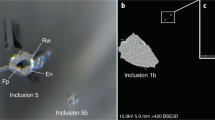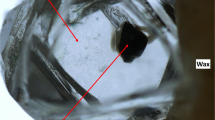Abstract
INCLUSIONS encapsulated by diamonds at the time of their formation provide a means for determining diamond crystallization ages and the chemistry of the surrounding upper mantle at that time. Sm–Nd studies of peridotitic inclusions, from Cretaceous-age kimberlites in southern Africa, suggest that the diamonds formed 3.3 Gyr ago1. By contrast, eclogite-suite inclusions generally yield younger ages, sometimes approaching the time of kimberlite erup-tion2–4. Here we report the results of 40Ar/39Ar laser-probe analy-ses of individual eclogitic clinopyroxene inclusions from Premier diamonds, which yield a mean age of 1,198 ±14 Myr. This age agrees well with Sm–Nd (ref. 2) and 40Ar/39Ar (ref. 3) analyses on similar Premier inclusions, and is indistinguishable from the inferred time of emplacement of the host kimberlite (1,150–1,230 Myr)2, which implies that diamond formation was essentially synchronous with kimberlite generation. The extrapolated non-radiogenic 40 Ar/36 Ar ratio of 334 ± 102 is similar to the present-day atmospheric composition. This value is inconsistent with Sr and Nd isotopic signatures from Premier eclogite inclusions2, which suggest a depleted mantle source (40Ar/36Ar > 20,000). Pre-entrap-ment equilibration of the inclusions with an 36Ar-rich fluid is the most probable explanation for the low non-radiogenic (40Ar/36Ar) composition.
This is a preview of subscription content, access via your institution
Access options
Subscribe to this journal
Receive 51 print issues and online access
$199.00 per year
only $3.90 per issue
Buy this article
- Purchase on Springer Link
- Instant access to full article PDF
Prices may be subject to local taxes which are calculated during checkout
Similar content being viewed by others
References
Richardson, S. H., Gurney, J. J., Erlank, A. J. & Harris, J. W. Nature 310, 198–202 (1984).
Richardson, S. H. Nature 322, 623–626 (1986).
Burgess, R., Turner, G., Laurenzi, M. & Harris, J. W. Earth planet. Sci. Lett. (in the press).
Smith, C. B., Gurney, J. J., Harris, J. W. & Jagoutz, E. Geocongress 88, 571–574 (Geological Society of South Africa, Johannesburg, 1988).
Melton, C. E. & Giardini, A. A. Geophys. Res. Lett. 7, 461–464 (1980).
Ozima, M., Zashu, S. & Nitoh, O. Geochem. J. 19, 127–134 (1985).
Ozima, M., Zashu, S. & Nitoh, O. Geochim, cosmochim. Acta 47, 2217–2224 (1983).
Honda, M., Reynolds, J. H., Roedder, E. & Epstein, S. J. Geophys Res. 92, 12507–12521 (1987).
Meyer, H. O. A. in Mantle Xenoliths (ed. Nixon, P. H.) 501–522 (Wiley, Chichester, 1988).
Gurney, J. J., Harris, J. W., Rickard, R. S. & Moore, R. O. Trans geol. Soc. S. Afr. 88, 301–310 (1985).
Boyd, F. R., Gurney, J. J. & Richardson, S. H. Nature 315, 387–389 (1985).
Hall, A. E. & Smith, C. B. in Kimberlite Occurrence and Origin: A Basis for Conceptual Models in Exploration (eds Glover, J. E. & Harris, P. G.) (University of Western Australia, Perth, 1984).
Kramers, J. D. Earth planet. Sci. Lett. 42, 58–70 (1979).
Zashu, S., Ozima, M. & Nitoh, O. Nature 323, 710–712 (1986).
Takaoka, N. & Ozima, M. Nature 271, 45–46 (1978).
Turner, G., Burgess, R., Laurenzi, M., Kelley, S. & Harris, J. W. Chem. Geol. 70, 142 (1988).
Phillips, D. & Onstott, T. C. Geology 16, 542–546 (1988).
Phillips, D. Isot. Geosci. (submitted).
Onstott, T. C. & Peacock, M. W. Geochim. cosmochim. Acta 51, 2891–2903 (1987).
Roddick, J. C., Cliff, R. A. & Rex, D. C. Earth planet Sci. Lett 48, 185–208 (1980).
York, D. Earth planet. Sci. Lett. 5, 320–324 (1969).
Fisher, D. E. Geochim. cosmochim. Acta 51, 2531–2541 (1987).
Allegre, C. J., Staudacher, T. & Sarda, P. Earth planet. Sci. Lett. 81, 127–150 (1986/7).
Helmstaedt, H. & Gurney, J. J. in Kimberlites. I: Kimberlites and Related Rocks (ed. Kornprobst, J.) 425–434 (Elsevier, Amsterdam, 1984).
Ringwood, A. E. Earth planet. Sci. Lett. 36, 443–448 (1987).
Schulze, D. J. Nature 319, 483–485 (1986).
Goldstein, S. L. Nature 336, 733–738 (1988).
Ozima, M., Takaoka, N., Nitoh, O. & Zashu, S. in Materials Science of the Earth's Interior (ed. Sunagawa, I.) 375–386 (Terra Scientific, Tokyo, 1984).
Samson, S. D. & Alexander, E. C. Isot. Geosci. 66, 27–34 (1987).
Author information
Authors and Affiliations
Rights and permissions
About this article
Cite this article
Phillips, D., Onstott, T. & Harris, J. 40Ar/39Ar laser-probe dating of diamond inclusions from the Premier kimberlite. Nature 340, 460–462 (1989). https://doi.org/10.1038/340460a0
Received:
Accepted:
Issue Date:
DOI: https://doi.org/10.1038/340460a0
This article is cited by
-
Mineral inclusions in Lace diamonds and the mantle beneath the Kroonstad kimberlite cluster in South Africa
Contributions to Mineralogy and Petrology (2022)
-
Three generations of diamonds from old continental mantle
Nature (1993)
-
Eclogitic diamonds of Proterozoic age from Cretaceous kimberlites
Nature (1990)
Comments
By submitting a comment you agree to abide by our Terms and Community Guidelines. If you find something abusive or that does not comply with our terms or guidelines please flag it as inappropriate.



